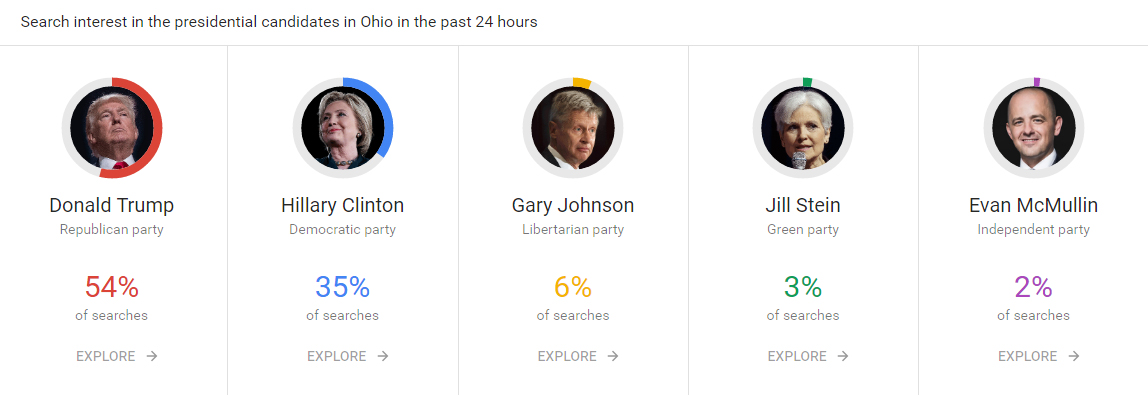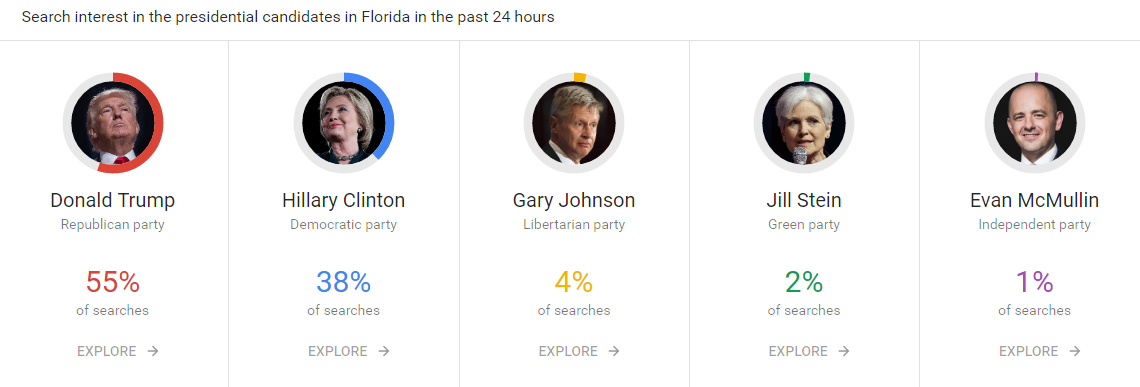
What can Google Trends tell us about the US “Swing States”?

*This only focuses on search data from Google and does not incorporate any pre-or-post Election polling data*
The above image displays search interest by candidate from the 6th - 8th November 2016. Admittedly, we're in a bit of a bubble in London, but woah. That's a lot of Republican red. This year both parties invested heavily in digital marketing strategies and many of us here have been keeping a keen eye on election race. While the US election result doesn't directly affect the UK, as a content marketing agency, a lot of us at MintTwist had those familiar feelings from the morning of the 24th of June - when the UK voted to leave the EU despite the Election Polls hinting at the opposite.
Echoing the EU-referendum results I was greeted with a similar response on my journey to work and is one of the only times I've seen people engage with one another on public transport. Catching eye contact of someone else didn't result in the standard look away but instead was greeted with a shrug of the shoulders, shake of the head or roll of the eyes.
This post will focus on two of the major swing states, Ohio & Florida. Specifically comparing the Google Trends search data against the final results.
Ultimately asking the question: Can Google predict the result better than polling data?
But first. A bit of info:

 We now have 100% reporting for Ohio with the Republicans taking 52.1% of the vote, Democrats accounting for 43.5% of overall votes & the Libertarian candidate taking 3.2%. While the search interest compared to the vote don't match completely, there's a correlation between search intent and results.
The key here is focusing on the majority of "search-share" rather than actual percentages. In Ohio the majority of candidate searches were Trump related - correlating with the election results
Focusing on search trends within individual districts of Ohio, we can see that not one went against the grain of the overall result. With 85% of Ohio demographic identifying itself as White, American - this may not come as a surprise to some.
Abortion is a hot-topic in Ohio; so it's unsurprising to see this reflected in district level searches. There are restrictions on abortion in Ohio and this has been debated heavily over the last few years. Currently, Ohio law states:
"A woman must receive state-directed counselling that includes information designed to discourage her from having an abortion and then wait 24 hours before the procedure is provided. Counselings must be provided in person and must take place before the waiting period begins, thereby necessitating two separate trips to the facility."
Around ~44% of the electorate in Ohio state are religious. With 17.72% are Catholic; 0.55% are LDS; 7.09% are another Christian faith. Which could go to explain why abortion is such a focus.
One could argue that search topics (and more specifically the change in these topics) be utilised to predict potential state-allegiances for political parties. I don't know enough about the specialism to comment, but I would be interested to see if campaign strategists are utilising this to personalise message state-by-state or district-by-district.
We now have 100% reporting for Ohio with the Republicans taking 52.1% of the vote, Democrats accounting for 43.5% of overall votes & the Libertarian candidate taking 3.2%. While the search interest compared to the vote don't match completely, there's a correlation between search intent and results.
The key here is focusing on the majority of "search-share" rather than actual percentages. In Ohio the majority of candidate searches were Trump related - correlating with the election results
Focusing on search trends within individual districts of Ohio, we can see that not one went against the grain of the overall result. With 85% of Ohio demographic identifying itself as White, American - this may not come as a surprise to some.
Abortion is a hot-topic in Ohio; so it's unsurprising to see this reflected in district level searches. There are restrictions on abortion in Ohio and this has been debated heavily over the last few years. Currently, Ohio law states:
"A woman must receive state-directed counselling that includes information designed to discourage her from having an abortion and then wait 24 hours before the procedure is provided. Counselings must be provided in person and must take place before the waiting period begins, thereby necessitating two separate trips to the facility."
Around ~44% of the electorate in Ohio state are religious. With 17.72% are Catholic; 0.55% are LDS; 7.09% are another Christian faith. Which could go to explain why abortion is such a focus.
One could argue that search topics (and more specifically the change in these topics) be utilised to predict potential state-allegiances for political parties. I don't know enough about the specialism to comment, but I would be interested to see if campaign strategists are utilising this to personalise message state-by-state or district-by-district.
 With a 100% reporting: Trump took 49.1% of the overall votes, with H Clinton accounting for 47.7% of all votes. Gary Johnson comes way behind with 2.2%. Again, comparing these search trends against the Election results we can see a slight correlation.
Unlike Ohio, Florida has some examples of districts going against the state in terms of "search intent". Gulf County, Franklin County & Gilchrist County had more [Hilary Clinton +] searches than [Donald Trump +] (remember, this can be positive or negative). On the whole, it's clear to see that the majority of Florida were behind (or at least interested in) Trump when it came to finding out more info via Google.
Similarly to Ohio the topics of Immigration & Abortion were "hot topic searches" on the lead-up to the election - often subjects many would associate with the Republicans.
With a 100% reporting: Trump took 49.1% of the overall votes, with H Clinton accounting for 47.7% of all votes. Gary Johnson comes way behind with 2.2%. Again, comparing these search trends against the Election results we can see a slight correlation.
Unlike Ohio, Florida has some examples of districts going against the state in terms of "search intent". Gulf County, Franklin County & Gilchrist County had more [Hilary Clinton +] searches than [Donald Trump +] (remember, this can be positive or negative). On the whole, it's clear to see that the majority of Florida were behind (or at least interested in) Trump when it came to finding out more info via Google.
Similarly to Ohio the topics of Immigration & Abortion were "hot topic searches" on the lead-up to the election - often subjects many would associate with the Republicans.
The importance of Swing States
Each state gets a number of "electors" (votes) - more-or-less proportional to the size/population of the state. Most states award their electoral votes on a "winner takes all" basis. So if most people vote Democrat in Hawaii, then the Democrats get their 4 electoral votes. In total, there are 538 electoral votes spread across the states, and a candidate needs a majority of 270 of them to win. Traditionally some states have been voting for the same party for years, and are party-loyal. 99% of the time Republicans are probably going to get Texas’s Electoral Votes. And if you’re a Democrat, then you’re probably going to get the same in California’s. However, Swing States aren't party loyal. They can give a party candidate the boost they need to win an election. This is why candidates have such a heavy focus on Florida, Ohio & Colorado. Historically, it has usually come down to these states in marginal elections to determine the President-elect. Swing States have played a key role in many of the US elections over the last 25 years, but there seems to have been a larger focus on the states of Florida & Ohio this time around.
Swing States in the 2012 US Election
The Washington Post stated that in the 2012 election there was a total of 9 true swing states. These were: Colorado, Florida, Iowa, Nevada , New Hampshire, North Carolina, Ohio, Virginia and Wisconsin. These 9 states contribute 110 of the 270 - or 41% votes needed to win. In 2012 the democrats took: Iowa, Colorado, Nevada, New Hampshire, Ohio, Virginia & Wisconsin. With the Republicans taking votes from North Carolina & Florida. One key switch we can see in in 2016 US election is the change of voting for Ohio. A competitive state with 18 electoral votes was crucial for Trump. The republicans gained 52.1% of the vote (or 454,983 more votes) compared to Clinton. The big-G have put together a Google Trends Story - enabling users to focus on search trends individual states & districts within the US. Let's focus on the 2 main swing states this Election; Ohio & Florida. Please take the below with a palm of salt as there is no way to determine the sentiment of these searches.Trends in Ohio -from the last 24 hours
Off all search activity related to presidential candidates, coming in top is Donald Trump. Accounting for a whopping 54% of all searches compared to Hilary's 35%. Gary Johnson comes way behind in third place 6% of all searches. We now have 100% reporting for Ohio with the Republicans taking 52.1% of the vote, Democrats accounting for 43.5% of overall votes & the Libertarian candidate taking 3.2%. While the search interest compared to the vote don't match completely, there's a correlation between search intent and results.
The key here is focusing on the majority of "search-share" rather than actual percentages. In Ohio the majority of candidate searches were Trump related - correlating with the election results
Focusing on search trends within individual districts of Ohio, we can see that not one went against the grain of the overall result. With 85% of Ohio demographic identifying itself as White, American - this may not come as a surprise to some.
Abortion is a hot-topic in Ohio; so it's unsurprising to see this reflected in district level searches. There are restrictions on abortion in Ohio and this has been debated heavily over the last few years. Currently, Ohio law states:
"A woman must receive state-directed counselling that includes information designed to discourage her from having an abortion and then wait 24 hours before the procedure is provided. Counselings must be provided in person and must take place before the waiting period begins, thereby necessitating two separate trips to the facility."
Around ~44% of the electorate in Ohio state are religious. With 17.72% are Catholic; 0.55% are LDS; 7.09% are another Christian faith. Which could go to explain why abortion is such a focus.
One could argue that search topics (and more specifically the change in these topics) be utilised to predict potential state-allegiances for political parties. I don't know enough about the specialism to comment, but I would be interested to see if campaign strategists are utilising this to personalise message state-by-state or district-by-district.
We now have 100% reporting for Ohio with the Republicans taking 52.1% of the vote, Democrats accounting for 43.5% of overall votes & the Libertarian candidate taking 3.2%. While the search interest compared to the vote don't match completely, there's a correlation between search intent and results.
The key here is focusing on the majority of "search-share" rather than actual percentages. In Ohio the majority of candidate searches were Trump related - correlating with the election results
Focusing on search trends within individual districts of Ohio, we can see that not one went against the grain of the overall result. With 85% of Ohio demographic identifying itself as White, American - this may not come as a surprise to some.
Abortion is a hot-topic in Ohio; so it's unsurprising to see this reflected in district level searches. There are restrictions on abortion in Ohio and this has been debated heavily over the last few years. Currently, Ohio law states:
"A woman must receive state-directed counselling that includes information designed to discourage her from having an abortion and then wait 24 hours before the procedure is provided. Counselings must be provided in person and must take place before the waiting period begins, thereby necessitating two separate trips to the facility."
Around ~44% of the electorate in Ohio state are religious. With 17.72% are Catholic; 0.55% are LDS; 7.09% are another Christian faith. Which could go to explain why abortion is such a focus.
One could argue that search topics (and more specifically the change in these topics) be utilised to predict potential state-allegiances for political parties. I don't know enough about the specialism to comment, but I would be interested to see if campaign strategists are utilising this to personalise message state-by-state or district-by-district.
Google Trends in Florida from the last 24 hours
Here we see the common themes between these two swing states. Trump taking 55% of the presidential searches, Hilary with 38% and Gary Johnson 4%. With a 100% reporting: Trump took 49.1% of the overall votes, with H Clinton accounting for 47.7% of all votes. Gary Johnson comes way behind with 2.2%. Again, comparing these search trends against the Election results we can see a slight correlation.
Unlike Ohio, Florida has some examples of districts going against the state in terms of "search intent". Gulf County, Franklin County & Gilchrist County had more [Hilary Clinton +] searches than [Donald Trump +] (remember, this can be positive or negative). On the whole, it's clear to see that the majority of Florida were behind (or at least interested in) Trump when it came to finding out more info via Google.
Similarly to Ohio the topics of Immigration & Abortion were "hot topic searches" on the lead-up to the election - often subjects many would associate with the Republicans.
With a 100% reporting: Trump took 49.1% of the overall votes, with H Clinton accounting for 47.7% of all votes. Gary Johnson comes way behind with 2.2%. Again, comparing these search trends against the Election results we can see a slight correlation.
Unlike Ohio, Florida has some examples of districts going against the state in terms of "search intent". Gulf County, Franklin County & Gilchrist County had more [Hilary Clinton +] searches than [Donald Trump +] (remember, this can be positive or negative). On the whole, it's clear to see that the majority of Florida were behind (or at least interested in) Trump when it came to finding out more info via Google.
Similarly to Ohio the topics of Immigration & Abortion were "hot topic searches" on the lead-up to the election - often subjects many would associate with the Republicans.